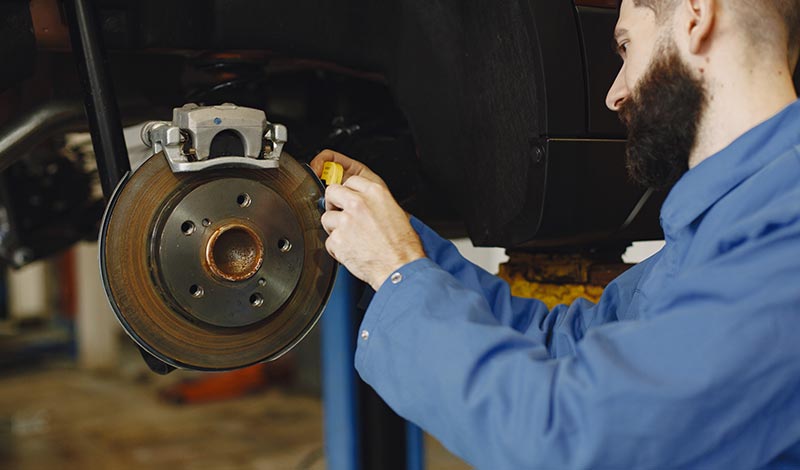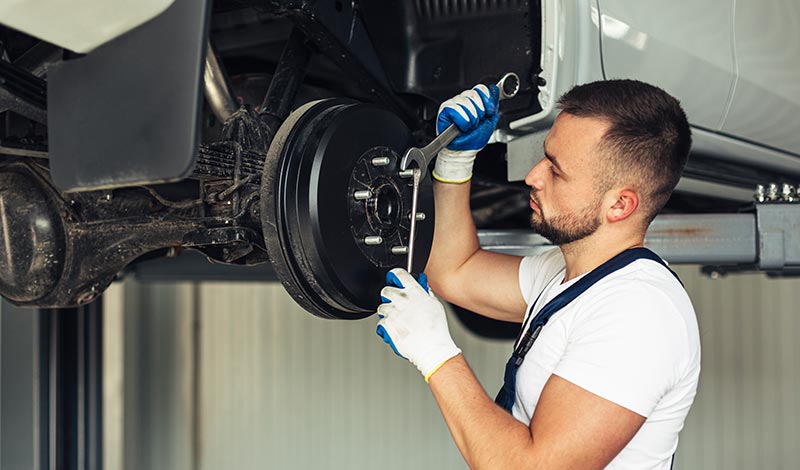Brake safety, a critical aspect of vehicle maintenance, demands regular attention to ensure road safety. The braking system, integral to your vehicle’s performance, plays a pivotal role in preventing accidents. Regular brake checks are not merely a maintenance routine; they are a fundamental safety measure. Over time, brakes undergo wear and tear, influenced by driving patterns, environmental conditions, and the vehicle’s age. Neglecting brake maintenance can lead to decreased efficiency, posing significant risks on the road.
By conducting routine brake inspections, you ensure that every component – pads, rotors, fluid, and calipers – functions optimally. This proactive approach not only enhances your safety but also contributes to the longevity of the braking system. Regular checks help identify potential issues early, preventing costly repairs and maintaining consistent brake performance. Moreover, understanding the condition of your brakes boosts your confidence as a driver, knowing that your vehicle is prepared for any situation.
Therefore, familiarizing yourself with the basics of brake maintenance and recognizing the signs of wear is crucial. In the following sections, we’ll delve into the components of the braking system, guide you through a detailed inspection routine, and offer tips for both DIY maintenance and professional services. Prioritizing brake safety is a responsibility every driver should embrace to ensure a safer journey for all.
Essential Brake Components: A Closer Look at What Needs Checking
Brake systems, complex in design yet critical for safety, comprise several key components, each requiring regular inspection for optimal performance. The brake pads, acting as the frictional interface with the brake rotors, are paramount in the braking process. Over time, pads wear down and necessitate replacement. Close monitoring of their thickness is essential, with experts recommending a minimum thickness of 1/4 inch.
Rotors, the discs that brake pads clamp onto, are equally vital. They should be checked for warping, cracks, or significant wear, as these can compromise braking efficiency. Alongside these, the brake calipers, which hold the brake pads and press them against the rotors, demand attention. Ensuring they move freely and are free of leaks is crucial.
Brake lines, responsible for carrying brake fluid, are prone to damage or corrosion. Regular checks for leaks or damage are imperative. The brake fluid itself, integral for transmitting force from the brake pedal to the pads, should be at the correct level and replaced as per the vehicle manufacturer’s guidelines.
Lastly, the brake’s master cylinder, the heart of the brake hydraulic system, requires inspection for leaks and fluid level. Regular checks of these components ensure the effective functioning of the entire brake system, crucial for safe driving.
The Brake Inspection Routine: Step-by-Step Guide
Regular brake inspections are crucial for ensuring vehicle safety. A thorough brake check involves several key steps. First, examine the brake pads and discs. The pads should have at least a quarter-inch of material remaining. Any less, and they need replacing. Look for uneven wear or deep grooves in the discs, which indicate the need for resurfacing or replacement.
Next, check the brake fluid level in the master cylinder. If it’s low, this could signal a leak or worn brake pads. The fluid should be clear and at the appropriate level; any discoloration or debris suggests it’s time for a change. Inspect the brake lines and hoses for cracks, leaks, or signs of wear.
Additionally, pay attention to the brake calipers, ensuring they are not leaking and move freely. Sticking calipers can cause uneven pad wear and impact braking performance. Finally, listen for any unusual sounds when applying the brakes, like grinding or squeaking, as these can be indicators of underlying issues.
By following this routine, drivers can identify potential problems early, ensuring their brakes remain in optimal condition for safe driving. Regular brake checks not only enhance safety but also prolong the lifespan of the brake system.
Recognizing Warning Signs: When Your Brakes Need Attention

Brake health is crucial for safe driving. Awareness of warning signs indicating brake issues can prevent accidents. Common symptoms include unusual noises, like screeching or grinding, signaling worn brake pads or discs. Another sign is a vibrating or pulsating brake pedal, often hinting at warped rotors. If the vehicle pulls to one side while braking, it may suggest uneven brake pad wear or a malfunctioning caliper. A spongy or soft brake pedal, requiring more pressure than usual, could indicate air in the brake lines or a fluid leak. Additionally, a burning smell during driving is a serious red flag, often pointing to overheated brakes or clutch issues. Dashboard warning lights, specifically the brake system light, should never be ignored as they are clear indicators of potential brake system problems.
Regularly checking these aspects can pre-emptively address brake issues, ensuring safety. If you experience any of these warning signs, it’s advisable to consult a professional mechanic promptly. Remember, timely maintenance not only extends the life of your brakes but also protects you and others on the road.Top of Form
DIY Brake Maintenance: Simple Checks You Can Do at Home
Maintaining your vehicle’s brakes is crucial for ensuring safety on the road. While some aspects of brake maintenance require professional assistance, there are several simple checks you can perform at home. Firstly, inspect the brake pads. Visible through the wheel’s spokes, the pad should be at least 1/4 inch thick. If it’s less, it’s time for a replacement. Additionally, listen for any unusual sounds when braking, such as squealing or grinding, which often indicate worn pads.
Next, check the brake fluid level. Locate the reservoir under the hood and ensure the fluid reaches the ‘Full’ line. If it’s low, top it up, but also consider why it might be low – a leak or brake wear could be the cause. The fluid should be clear or slightly yellowish; if it’s dark, it needs changing.
Regularly checking the brake lines for any signs of leaks or damage is also important. A leak in the brake line can lead to brake failure, so any signs of fluid on the ground where you park your vehicle should be investigated immediately.
By conducting these simple maintenance checks at home, you can spot potential issues early and ensure your brakes remain in optimal condition, keeping you and others safe on the road.
Professional Brake Services: When to Seek Expert Help
Regular brake checks are crucial for ensuring your vehicle’s safety. While many aspects of brake maintenance can be handled at home, certain situations necessitate professional assistance. It’s essential to recognize when to seek expert help to maintain optimal brake performance. One key instance is when you notice persistent issues after performing basic checks and maintenance at home. If problems like unusual noises, vibrations, or decreased stopping power persist, it indicates a deeper issue that requires a professional’s expertise.
Moreover, during routine maintenance, if you encounter components like brake pads worn beyond the manufacturer’s recommended limit, or if the brake fluid appears dirty or is at a critically low level, it’s time to visit a professional. They possess the necessary tools and skills to address complex brake problems, ensuring your safety on the road.
Additionally, if your vehicle’s brake system warning light illuminates, it’s a direct signal to consult a professional immediately. This could indicate a serious malfunction that might not be apparent during a visual inspection. Professionals can diagnose and rectify such issues, often preventing more costly repairs in the future.
In summary, while regular brake checks can be conducted at home, recognizing when to seek professional services is key to maintaining your vehicle’s brake system effectively and ensuring road safety.
Seasonal and Environmental Factors Affecting Brake Performance
Optimal brake performance stands as a critical factor in vehicular safety and is significantly influenced by both seasonal variations and environmental conditions. The adept driver recognizes that the shift from sweltering summer heat to the biting cold of winter can wreak havoc on brake systems. During winter, for instance, road salts and moisture collectively pose a corrosive threat to brake components, potentially leading to decreased efficacy and longevity. Conversely, in summer, elevated temperatures can precipitate the deterioration of brake fluid and the warping of brake components, which may manifest as uncharacteristic noises or a spongy pedal feel.
Furthermore, drivers traversing mountainous terrain or coastal paths must stay vigilant about the added strain on braking systems. Steep declines necessitate prolonged brake application, culminating in heightened wear and potential overheating, while salty sea air can accelerate corrosion. Thus, adapting maintenance strategies to counteract these environmental stressors is paramount for ensuring consistently dependable braking.
Drivers should endeavor to incorporate seasonal checks into their vehicular maintenance routine, effectively mitigating the impact of environmental extremities. By assiduously attending to these variables, one not only prolongs the functional lifespan of their brakes but also reinforces overall road safety.
Maintaining reliable braking capability is essential, especially in unforeseen emergency scenarios where the difference between safety and calamity may hinge on the milliseconds it takes to come to a stop. As such, regular inspection and maintenance of brake systems are indispensable, ensuring all components are functioning at their optimum.
Safety Tips: Ensuring Reliable Braking in Emergency Situations

Seasonal changes and environmental factors contribute significantly to the performance of brakes. In the colder months, for instance, brakes may require more force to achieve the same stopping power as in warmer weather. Frost, ice, and even rust from excess moisture can impair brake responsiveness. Preemptive winterization checks, including a review of brake fluid for water content, can help drivers navigate plunging temperatures with confidence.
During summer, the heat can cause brake fluid to deteriorate or even evaporate, potentially leading to brake fade or failure. High temperatures also increase the risk of the brake pads and rotors wearing down more quickly because of the expansion of the metal, underlining the importance of checks during seasonal shifts.
In addition to temperature-related variations, environmental factors such as road salt, dust, and sand can erode braking systems. Regular cleaning and maintenance become crucial in areas where these elements are prevalent.
Implementing strategic driving habits, such as engine braking down inclines to conserve brake pad life, can also fortify one’s brakes against undue wear and tear. Anticipatory driving—maintaining distance from the car ahead and avoiding abrupt stops—extends the lifespan of the brakes and enhances safety.
Ultimately, understanding how seasonal and environmental factors can affect brake functionality is key. By conducting timely maintenance and adapting driving habits accordingly, drivers can ensure dependable braking performance, particularly in critical moments where responsive braking is imperative.
Conclusion: Maintaining Brake Health for Road Safety
In conclusion, maintaining brake health is paramount for ensuring safety on the roads. It’s a subject that requires continuous attention and awareness, not just for personal safety, but for the protection of all road users. Regular checks and maintenance of your vehicle’s braking system may seem like a routine task, yet they are essential practices that can have far-reaching implications. Simple actions such as monitoring brake pad thickness, checking for fluid leaks, and being attentive to changes in braking behavior can save lives. Additionally, understanding the need for professional services when complex issues arise is critical. Cultivating good driving habits, accounting for environmental factors, and adhering to a maintenance schedule, can significantly extend the life of your brakes. Adhering to these guidelines will invariably lead to better, more responsive braking and ultimately contribute to a safer driving experience. Remember, brakes are not just a vehicle component; they are the cornerstone of proactive road safety.

